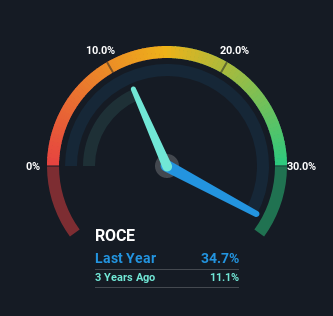- United States
- /
- Gas Utilities
- /
- NYSE:BIPC
Brookfield Infrastructure (NYSE:BIPC) Is Achieving High Returns On Its Capital

If we want to find a potential multi-bagger, often there are underlying trends that can provide clues. In a perfect world, we'd like to see a company investing more capital into its business and ideally the returns earned from that capital are also increasing. This shows us that it's a compounding machine, able to continually reinvest its earnings back into the business and generate higher returns. So when we looked at the ROCE trend of Brookfield Infrastructure (NYSE:BIPC) we really liked what we saw.
Return On Capital Employed (ROCE): What Is It?
Just to clarify if you're unsure, ROCE is a metric for evaluating how much pre-tax income (in percentage terms) a company earns on the capital invested in its business. Analysts use this formula to calculate it for Brookfield Infrastructure:
Return on Capital Employed = Earnings Before Interest and Tax (EBIT) ÷ (Total Assets - Current Liabilities)
0.35 = US$1.2b ÷ (US$9.2b - US$5.6b) (Based on the trailing twelve months to September 2022).
Therefore, Brookfield Infrastructure has an ROCE of 35%. That's a fantastic return and not only that, it outpaces the average of 5.4% earned by companies in a similar industry.
Our analysis indicates that BIPC is potentially undervalued!

Above you can see how the current ROCE for Brookfield Infrastructure compares to its prior returns on capital, but there's only so much you can tell from the past. If you're interested, you can view the analysts predictions in our free report on analyst forecasts for the company.
What Does the ROCE Trend For Brookfield Infrastructure Tell Us?
We're pretty happy with how the ROCE has been trending at Brookfield Infrastructure. We found that the returns on capital employed over the last four years have risen by 232%. That's not bad because this tells for every dollar invested (capital employed), the company is increasing the amount earned from that dollar. Interestingly, the business may be becoming more efficient because it's applying 60% less capital than it was four years ago. A business that's shrinking its asset base like this isn't usually typical of a soon to be multi-bagger company.
For the record though, there was a noticeable increase in the company's current liabilities over the period, so we would attribute some of the ROCE growth to that. Effectively this means that suppliers or short-term creditors are now funding 61% of the business, which is more than it was four years ago. Given it's pretty high ratio, we'd remind investors that having current liabilities at those levels can bring about some risks in certain businesses.
The Bottom Line
In the end, Brookfield Infrastructure has proven it's capital allocation skills are good with those higher returns from less amount of capital. Since the stock has returned a solid 24% to shareholders over the last year, it's fair to say investors are beginning to recognize these changes. Therefore, we think it would be worth your time to check if these trends are going to continue.
If you'd like to know more about Brookfield Infrastructure, we've spotted 3 warning signs, and 1 of them is potentially serious.
If you'd like to see other companies earning high returns, check out our free list of companies earning high returns with solid balance sheets here.
Valuation is complex, but we're here to simplify it.
Discover if Brookfield Infrastructure might be undervalued or overvalued with our detailed analysis, featuring fair value estimates, potential risks, dividends, insider trades, and its financial condition.
Access Free AnalysisHave feedback on this article? Concerned about the content? Get in touch with us directly. Alternatively, email editorial-team (at) simplywallst.com.
This article by Simply Wall St is general in nature. We provide commentary based on historical data and analyst forecasts only using an unbiased methodology and our articles are not intended to be financial advice. It does not constitute a recommendation to buy or sell any stock, and does not take account of your objectives, or your financial situation. We aim to bring you long-term focused analysis driven by fundamental data. Note that our analysis may not factor in the latest price-sensitive company announcements or qualitative material. Simply Wall St has no position in any stocks mentioned.
About NYSE:BIPC
Brookfield Infrastructure
Owns and operates regulated natural gas transmission systems in Brazil.
Fair value unattractive dividend payer.

